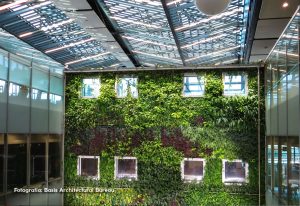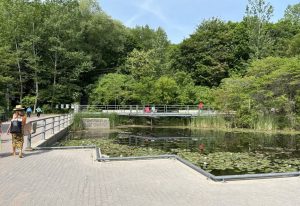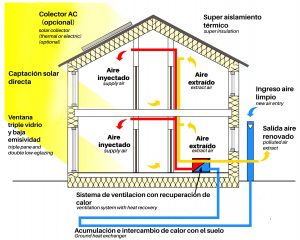
Landscaping: the best weapon against climate change
Learn with Ivonne walls about Landscaping: the best weapon against climate change.
Global climate change is the defining environmental problem of our time. From devastating wildfires to torrential storms, rising seas and the melting of the planet’s poles, the effects are already being felt and will continue to worsen.
The cities of the world live in constant evolution and change from population growth, so the urban landscape has had to adapt not only to technological development, but also to environmental processes that demand a solution to climate change that is mainly produced by human action to consume fossil fuels, excessive expenditure of electricity and the replacement of natural soils by impermeable plates that affect their nature. Natural factors due to the constant evolutionary process of the planet, such as volcanism and tectonic activity, also contribute, although to a lesser extent, to the negative effects of climate change. Today’s landscaping requires integrating the environmental variable to the aesthetic component, adapting the design to the conditions and care of natural resources. Natural landscapes represent within the urban ecosystem, pieces of nature that contribute to the balance of the local environmental system.

Green wall
Photography: pexels-magda-ehlers-1188834
The objective of sustainable design is to achieve a landscape with low energy consumption, which preserves natural resources and values endemic plant elements and species with low water requirements and easy adaptation. Continuing to ignore these factors can lead to the death of millions of people from health problems, famine, floods, wars, mass migrations, etc. It is important to remember that the effect of climate change on wildlife populations is also evident and grim. Massive losses of biodiversity due to temperature changes, new rainfall patterns and extreme weather events such as wildfires, coupled with human activities that turn landscapes into monoculture plantations, suburbs or polluting industrial sites into the remaining natural ecosystems, means that countless species will migrate and seek refuge in new places or disappear.
This is where the work of landscape architects becomes transcendental, since they are faced with the great challenge of mitigating and combating their negative effects by waging a colossal battle where their best weapon is, on one hand, the design of interventions that improve the current conditions of the sites, and on the other hand, the project of sustainable and resistant spaces that do not neglect functionality and aesthetics. In general terms, there are two types of strategies to mitigate and/or counteract climate change: mitigation and adaptation. Mitigation measures are aimed at reducing greenhouse gas emissions, while adaptation measures focus on reducing vulnerability and risks generated by climate change and, for the specific case of urban infrastructure and buildings, seek to strengthen the resilience of buildings.

Evergreen bricks Toronto
Photography: Valentina Lara
They refer mainly to actions in buildings such as promoting energy savings using renewable energies, proper waste management, the integration of vegetation in projects (such as roofs, walls and green terraces), and the incorporation of elements that facilitate the use of non-motorized transport (such as parking for bicycles or charging stations for electric vehicles). These measures can be applied, both in existing buildings, and in new buildings called green, sustainable or bioclimatic buildings. On the other hand, adaptation strategies are related to the specific context in which buildings are located. For example, in a context where water is a scarce resource or there are desertification processes, an efficient use of water (reduction of expenditure and/or treatment of it) should be promoted, the installation of a system for the collection and treatment of gray or black water for use, for example, in irrigation or discharges of toilets, etc. Some recommendations to reduce the effects of climate change through landscape design are:
Right plant, right place. Select plants related to the soil, light, water and climatic conditions of a site.
Rain collection in houses and buildings from the downstreams. This can be used for watering plants and trees, as well as in sanitary furniture.
Build rainwater collection tanks in parks and open spaces, to generate significant water savings. Reduce the surface of grass in gardens, parks and squares, incorporating arid materials to the design, since grass requires the greatest amount of water for its conservation.
Incorporate an efficient irrigation system, which conserves water and helps keep fertilizers and other pollutants from flowing into water bodies or drains. For example, using solar distillation irrigation, which reduces water consumption 10 times more than with traditional irrigation. With this technique, seawater can also be desalinated, collecting the resulting distillate.
Fertilize properly, to improve growth, increase flowering and fruiting, correct nutritional deficiencies and improve the appearance of plants without harming the environment.

Attract wildlife
Photography: pexels-photo-97533
Attract wildlife by selecting plants with seeds, fruits, foliage or flowers that provide food for native wildlife. Also, supply water sources for it.
Manage pests responsibly to prevent disease and insect outbreaks, using plants resistant to them.
Process organic and/or vegetable waste from parks and homes, to reincorporate them into the land as fertilizer.
Use porous pavements that allow water to filter into the subsoil.
Treat gray water from collection tanks, washing machines and laundries, so that it can be reused.
Design buildings and urban elements near seas, rivers, lakes and lagoons considering future water level rises, storms and other natural phenomena, and create ecological barriers in existing ones. In hot or desert areas, promote the conservation of wetlands, fertilization and hydration of soils.
Incorporate adequate spaces and environments to avoid invasive fauna species, protect vulnerable native ones and provide the ecological infrastructure to preserve them considering new and future climate conditions.
Revitalize any land, (garbage dumps, unused areas or vacant land), to turn it, for example, into a resilient refuge for wildlife. Attention to the ecology of the land and its potential to foster biodiversity should not be separated from landscape proposals to offset the impacts of climate change on vulnerable species, not only plants, but also animals.
Concepts such as xeriscape (derived from the Greek “xeros”, meaning dry, and “scape”, from English meaning scene), are emerging as a response to the challenge of climate change in dry or desert environments. It consists of using slow-growing and drought-tolerant plants to conserve water and establish an efficient and residue-free landscape.

Attract wildlife
Photography: pexels-photo-1133957
On the other hand, the “Passive House ”, developed in Germany, represents an example of a low-energy house for temperate/ cold climates. Due to the excellent thermal quality of its materials (walls, windows and doors), the good use of internal heat sources (from electrical devices normally used in homes) and the minimization of ventilation losses with a controlled system with heat recovery, this “passive ” house does not need conventional heating appliances, resulting in a 90% reduction in average consumption.
To minimize excess summer heat, natural ventilation is used at night and shaded areas are created during the day. In short, the Passive House model meets tomorrow’s energy efficiency requirements today. As designers, they will have to stop looking at the leaves and start looking at the roots of the problem. Landscape architects will need to be sensitive to ecology, particularly in critically sensitive areas, and respect it as much as the other facets of their work.

Passive House
Illustration: Michka B, CC BY-SA 4.0, via Wikimedia Commons
Their work consists of making art with life, which entails the responsibility of carrying out landscape architecture projects with the potential to promote biodiversity, offset the impacts of climate change on vulnerable species and improve the environmental imbalance that threatens to end the life of our planet in the not too distant future.
Each effort will also result in an improvement in the quality of life of today’s inhabitants on earth and in the proposal and implementation of a better world for those who will come after. Although it seems like a titanic task, we can also help with simple and accessible actions such as planting some local trees and sheds properly, building a small garden in our garden or collecting water systematically. We can also raise awareness in others to join this fight. With these small actions we can face this challenge together, in benefit of all of us.











